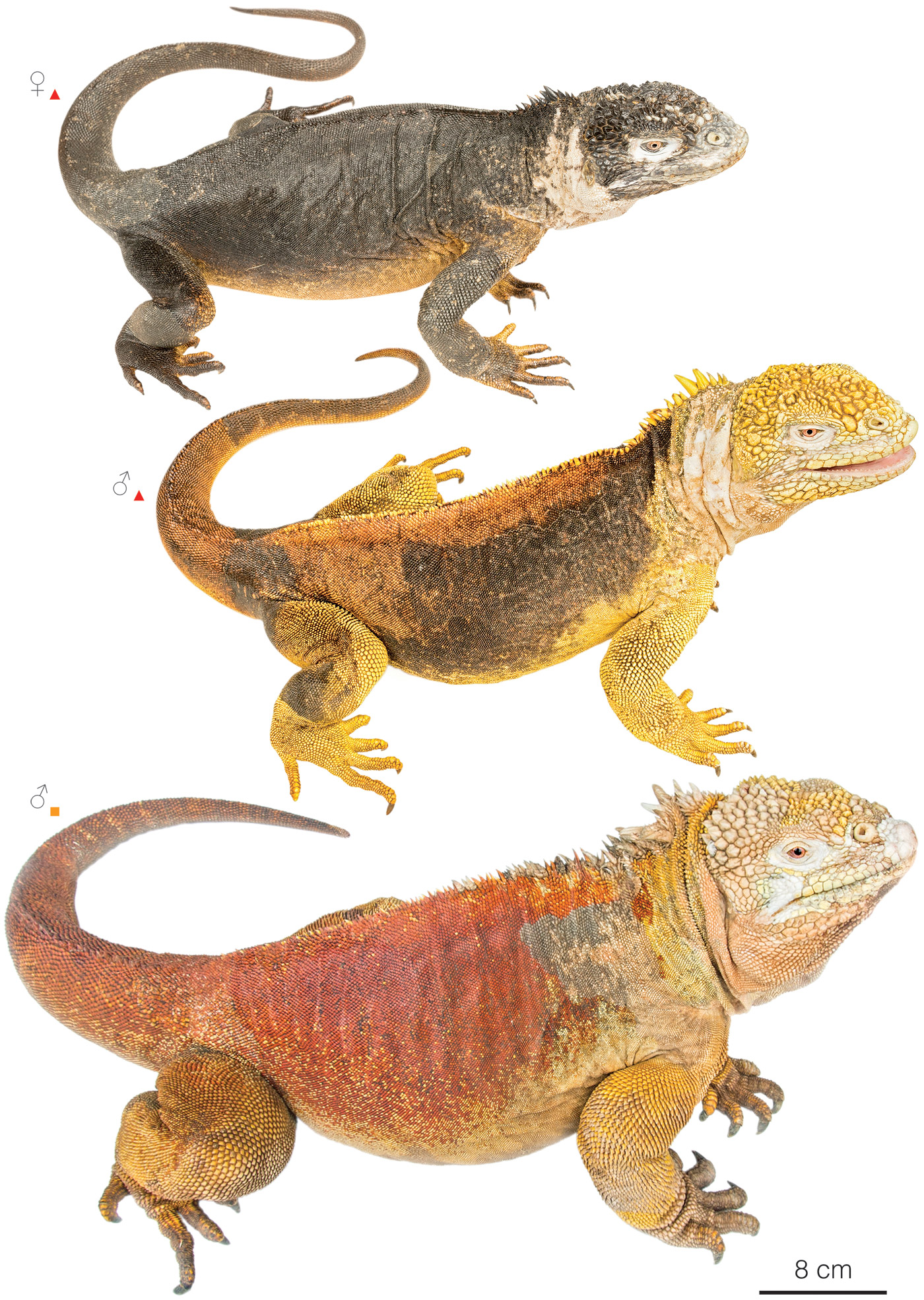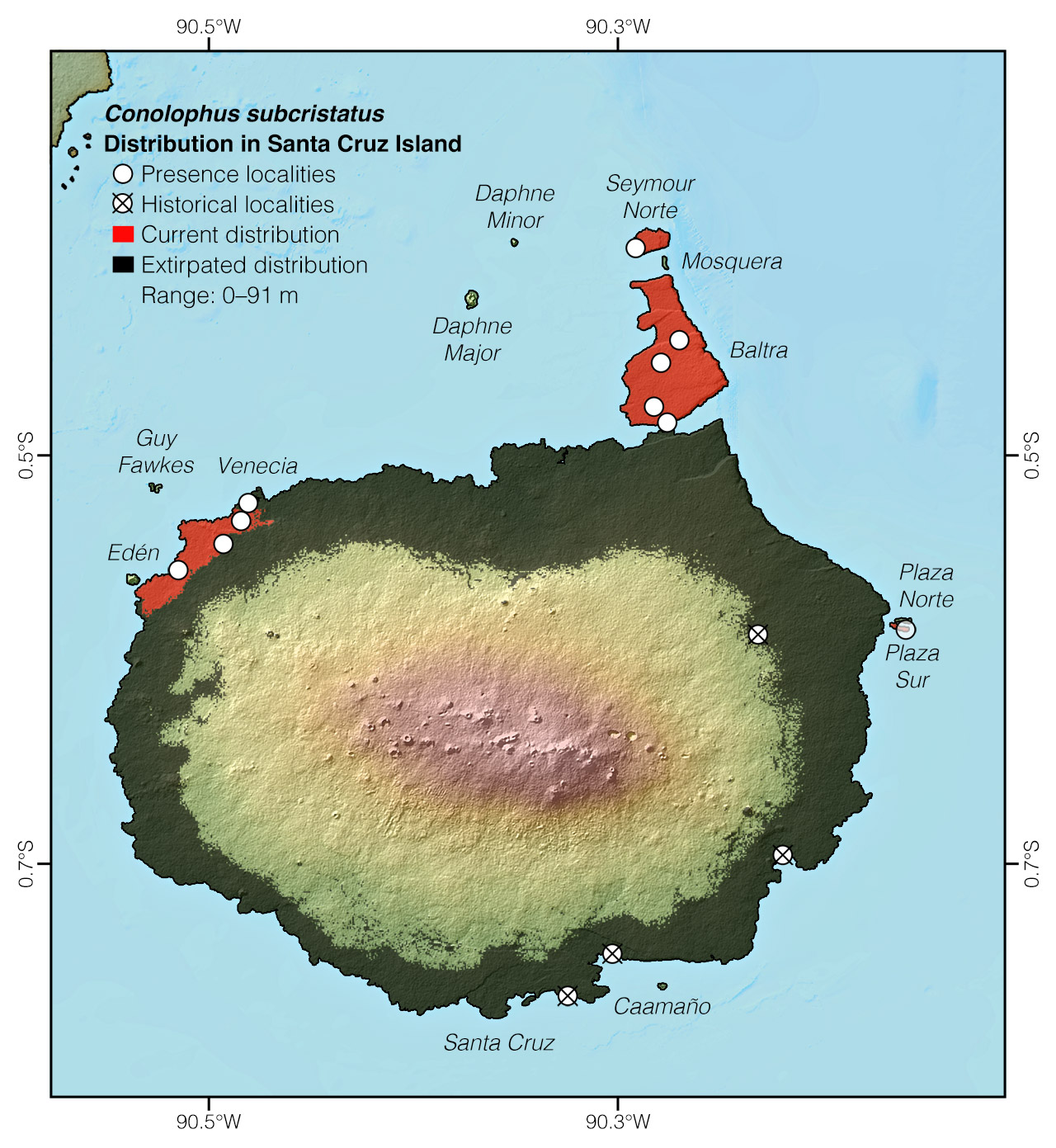Published October 10, 2019. Updated December 16, 2023. Open access. Peer-reviewed. | Purchase book ❯ |
Galápagos Land-Iguana (Conolophus subcristatus)
Reptiles of Ecuador | Sauria | Iguanidae | Conolophus subcristatus
English common name: Galápagos Land-Iguana.
Spanish common name: Iguana terrestre de Galápagos.
Recognition: ♂♂ 107 cmMaximum distance from the snout to the tip of the tail. Snout–vent length=60 cm. ♀♀ 91.8 cmMaximum distance from the snout to the tip of the tail. Snout–vent length=50 cm..1,2 Conolophus subcristatus is one of four species of iguanas in the Galápagos Islands. It is generally the only land-dwelling iguana wherever it occurs. On Wolf Volcano on northern Isabela Island, it coexists with the distinctively colored Pink Iguana (C. marthae), from which it differs by having a yellowish coloration and no black bands (Fig. 1). In coastal areas of some islands, the territory of the Galápagos Land-Iguana approaches the habitat of the Marine Iguana (Amblyrhynchus cristatus), a reptile that has a blunt snout, a laterally flattened tail adapted to swimming, and a distinct, usually blackish, background color.1

Figure 1: Individuals of Conolophus subcristatus from Galápagos, Ecuador: Plaza Sur Island (); Seymour Norte Island ().
“Like their brothers the sea-kind, they are ugly animals, of a yellowish orange beneath, and of a brownish red colour above: from their low facial angle they have a singularly stupid appearance.”
Charles Darwin, 1835.3
Natural history: Conolophus subcristatus is a diurnal iguana that inhabits dry shrublands, dry grasslands, deciduous forests, and volcanic rock areas if there is vegetation nearby.1 Galápagos Land-Iguanas are terrestrial to semi-arboreal and feed mostly on, and obtain water from,1 cacti, grasses, and the leaves of trees. Their diet also includes berries, seeds, crabs, crickets, grasshoppers, carrion, and shed skin.4 These reptiles are most active between 8:00–10:00 am and 3:00–6:00 pm.4 When not active, they retreat into burrows, under thick vegetation, or in crevices in the lava rocks.5 Galápagos Land-Iguanas, especially juveniles, are preyed upon by introduced predators such as pigs, dogs, cats, and rats, as well as by native predators such as hawks and snakes (Pseudalsophis dorsalis and P. occidentalis).1,2 When threatened, these fast and wary reptiles run into burrows, vegetation, and crevices. They may also open their mouths aggressively if cornered. Adult females compete fiercely over nesting sites and are capable of traveling for up to 40 km to arrive at suitable nesting grounds.6 They dig holes in sandy soil4 and lay 8–22 eggs6 that take nearly four months to hatch.7 Adult males defend their territories by bobbing their heads or fighting with intruders.6 The Galápagos Land-Iguana is known to hybridize with the Marine Iguana (Amblyrhynchus cristatus) on Plaza Sur Island.8 Members of C. subcristatus are estimated to live up to 70 years.7
Conservation: Vulnerable Considered to be facing a high risk of extinction in the mid-term future..9 Conolophus subcristatus is listed in this category given that the entire population is estimated to be composed of less than 10,000 mature individuals,2 many subpopulations are either extinct (Santiago and Rábida islands)7 or nearly extinct (most of Santa Cruz and southern Isabela Island),2 and the species faces the threat of invasive predators.7
“The individuals, and they are the greater number, which inhabit the lower country, can scarcely taste a drop of water throughout the year; but they consume much of the succulent cactus, the branches of which are occasionally broken off by the wind.”
Charles Darwin, 1835.1
Distribution: Conolophus subcristatus is endemic to an area of approximately 5,401 km2 in Galápagos, Ecuador (Fig. 2). Galápagos Land-Iguanas occur on Baltra, Isabela, Fernandina, Seymour Norte, Plaza Sur, and Santa Cruz islands (Fig. 3). The species has been re-introduced to Santiago Island and extirpated from Rábida Island.

Figure 2: Distribution of Conolophus subcristatus in Galápagos. See Appendix 1 for a complete list of the presence localities included in the map.

Figure 3: Distribution of Conolophus subcristatus in Santa Cruz Island. See Appendix 1 for a complete list of the presence localities included in the map.
Etymology: The generic name Conolophus comes from the Greek words konos (=cone) and lophos (=crest),10 and refers to the cone-like scales that compose the dorsal crest in species of this genus. The specific epithet subcristatus comes from the Latin words sub (=less than), crista (=ridge), and the suffix -atus (=provided with).10 It refers to the comparatively small dorsal crest of this species.1
See it in the wild: The easiest places to see Galápagos Land-Iguanas are Plaza Sur and Seymour Norte islands. At these tourism sites, individuals of Conolophus subcristatus can be seen year-round with almost complete certainty.
Special thanks to Shannon DeVaney and Kathryn Tosney for symbolically adopting the Galápagos Land-Iguana and helping bring the Reptiles of Ecuador book project to life.
Click here to adopt a species.
Authors: Alejandro ArteagaaAffiliation: Fundación Khamai, Reserva Arlequín, Ecoruta Paseo del Quinde km 56, Santa Rosa de Mindo, Pichincha 171202, Ecuador. and Juan M GuayasaminbAffiliation: Universidad San Francisco de Quito, Quito, Ecuador.
Academic reviewer: Miguel VencescAffiliation: Technische Universität Braunschweig, Braunschweig, Germany.
Photographers: Alejandro ArteagaaAffiliation: Fundación Khamai, Reserva Arlequín, Ecoruta Paseo del Quinde km 56, Santa Rosa de Mindo, Pichincha 171202, Ecuador. and Jose VieiradAffiliation: Tropical Herping (TH), Quito, Ecuador.,eAffiliation: ExSitu, Quito, Ecuador.
How to cite? Arteaga A, Guayasamin JM (2023) Galápagos Land-Iguana (Conolophus subcristatus). In: Arteaga A, Bustamante L, Vieira J (Eds) Reptiles of Ecuador: Life in the middle of the world. Available from: www.reptilesofecuador.com. DOI: 10.47051/CAND9772
Literature cited:
- Arteaga A, Bustamante L, Vieira J, Tapia W, Guayasamin JM (2019) Reptiles of the Galápagos: Life on the Enchanted Islands. Tropical Herping, Quito, 208 pp.
- Márquez CM, Muñoz EA, Gentile G, Tapia WH, Zabala FJ, Naranjo SA, Llerena AJ (2010) Estado poblacional de las iguanas terrestres (Conolophus subcristatus, C. pallidus, y C. marthae: Squamata, Iguanidae), Islas Galápagos. Boletín Técnico, Serie Zoológica 6: 25–43.
- Darwin CR (1845) Journal of researches into the natural history and geology of the countries visited during the voyage of H.M.S. Beagle round the world, under the command of Capt. Fitz-Roy, R.N. John Murray, London, 519 pp.
- Carpenter CC (1969) Behavioral and ecological notes on the Galápagos land iguanas. Herpetologica 25: 155–164.
- Van Denburgh J, Slevin JR (1913) Expedition of the California Academy of Sciences to the Galápagos Islands, 1905-1906. IX. The Galapagoan lizards of the genus Tropidurus with notes on iguanas of the genera Conolophus and Amblyrhynchus. Proceedings of the California Academy of Sciences 2: 132–202.
- Werner DI (1983) Reproduction in the iguana Conolophus subcristatus on Fernandina Island, Galápagos: clutch size and migration costs. The American Naturalist 121: 757–775.
- Snell HL, Snell HM, Tracy CR (1984) Variation among populations of Galápagos land iguanas (Conolophus): contrasts of phylogeny and ecology. Biological Journal of the Linnean Society 21: 185–207. DOI: 10.1111/j.1095-8312.1984.tb02061.x
- Rassmann K, Trillmich F, Tautz D (1997) Hybridization between the Galápagos land and marine iguana (Conolophus subcristatus and Amblyrhynchus cristatus) on Plaza Sur. Journal of Zoology 242: 729–739. DOI: 10.1111/j.1469-7998.1997.tb05822.x
- Kumar K, Gentile G, Grant TD (2020) Conolophus subcristatus. The IUCN Red List of threatened species. Available from: www.iucnredlist.org. DOI: 10.2305/IUCN.UK.2020-2.RLTS.T5240A3014082.en
- Brown RW (1956) Composition of scientific words. Smithsonian Books, Washington, 882 pp.
Appendix 1: Locality data used to create the distribution map of Conolophus subcristatus in Ecuador (Fig. 2). Go to the section on symbols and abbreviations for a list of acronyms used.
| Country | Province | Locality | Source |
| Ecuador | Galápagos | Bahía Elizabeth | Gentile et al 2009 |
| Ecuador | Galápagos | Baltra | Arteaga et al. 2019 |
| Ecuador | Galápagos | Baltra airport | Arteaga et al. 2019 |
| Ecuador | Galápagos | Banks Bay | Van Denburgh 1913 |
| Ecuador | Galápagos | Cabo Douglas | Traveset et al 2016 |
| Ecuador | Galápagos | Cape Berkeley | CAS 11490; VertNet |
| Ecuador | Galápagos | Cartago Bay | Werner 1983 |
| Ecuador | Galápagos | Cazuela | Márquez et al 2010 |
| Ecuador | Galápagos | Cerro Colorado | Snell et al 1984 |
| Ecuador | Galápagos | Cerro Dragón | Constantini et al 2009 |
| Ecuador | Galápagos | Cerro Grande | Márquez et al 2010 |
| Ecuador | Galápagos | Cerro Montura | Constantini et al 2009 |
| Ecuador | Galápagos | Cerro Paloma | Márquez et al 2010 |
| Ecuador | Galápagos | Conway Bay | MVZ 67726; VertNet |
| Ecuador | Galápagos | Cráter Beagle | Márquez et al 2010 |
| Ecuador | Galápagos | Crater of La Cumbre | Arteaga et al. 2019 |
| Ecuador | Galápagos | Crater of Wolf Volcano | Gentile et al 2016 |
| Ecuador | Galápagos | Cueva Norte | Gentile et al 2009 |
| Ecuador | Galápagos | E Slope of Sierra Negra | Márquez et al 2010 |
| Ecuador | Galápagos | E Tortuga Bay | Snell et al 1984 |
| Ecuador | Galápagos | El Garrapatero | Van Denburgh 1913 |
| Ecuador | Galápagos | Ensenada Buccaneer (reintroducida) | Arteaga et al. 2019 |
| Ecuador | Galápagos | Estación Charles Darwin | Arteaga et al. 2019 |
| Ecuador | Galápagos | Inland from Bahía Urbina | Márquez et al 2010 |
| Ecuador | Galápagos | Inland from Cueva Norte | Márquez et al 2010 |
| Ecuador | Galápagos | Itabaca–Baltra airport 1 | Arteaga et al. 2019 |
| Ecuador | Galápagos | Itabaca–Baltra airport 2 | Arteaga et al. 2019 |
| Ecuador | Galápagos | James Bay | Darwin 1839 |
| Ecuador | Galápagos | La Cumbre volcano | Arteaga et al. 2019 |
| Ecuador | Galápagos | N Slope of Cerro Azul Volcano A | Márquez et al 2010 |
| Ecuador | Galápagos | N Slope of Cerro Azul Volcano B | Márquez et al 2010 |
| Ecuador | Galápagos | N Slope of Sierra Negra | Márquez et al 2010 |
| Ecuador | Galápagos | NW rim of Wolf Volcano | Giambattista & Gentile 2018 |
| Ecuador | Galápagos | Piedras Blancas | Gentile et al 2009 |
| Ecuador | Galápagos | Plaza Sur | Arteaga et al. 2019 |
| Ecuador | Galápagos | Puerto Bravo | Gentile et al 2009 |
| Ecuador | Galápagos | Puerto Nuevo (reintroducida) | Arteaga et al. 2019 |
| Ecuador | Galápagos | Puerto Villamil | Gentile et al 2009 |
| Ecuador | Galápagos | Punta Espinosa | OMNH 40552.0; VertNet |
| Ecuador | Galápagos | Punta Espinosa, 3 miles N of | LACM 19386; VertNet |
| Ecuador | Galápagos | Punta García | Márquez et al 2010 |
| Ecuador | Galápagos | Rábida | Giambattista & Gentile 2018 |
| Ecuador | Galápagos | Roca Limba | Gentile et al 2009 |
| Ecuador | Galápagos | SE Alcedo Volcano | Snell et al 1984 |
| Ecuador | Galápagos | SE Darwin Volcano | Snell et al 1984 |
| Ecuador | Galápagos | Seymour Norte | CM 17076; VertNet |
| Ecuador | Galápagos | SW Cape Berkeley | Fritts and Fritts 1982 |
| Ecuador | Galápagos | Tagus cove | CAS 11274; VertNet |
| Ecuador | Galápagos | Urbina | Arteaga et al. 2019 |
| Ecuador | Galápagos | Venecia | Gentile et al 2009 |
| Ecuador | Galápagos | Volcán Chico | Márquez et al 2010 |
| Ecuador | Galápagos | W Slope of Darwin Volcano | Márquez et al 2010 |
| Ecuador | Galápagos | Wolf Volcano Camp 2 | Arteaga et al. 2019 |
| Ecuador | Galápagos | Wolf Volcano Camp 3 | Arteaga et al. 2019 |
| Ecuador | Galápagos | Wolf Volcano Camp 4 | Arteaga et al. 2019 |